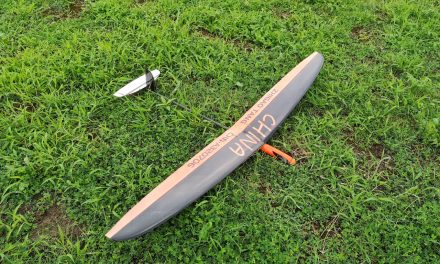
NEOS
2.4 gHz compatible!
Manufacturer: ArmSoar Composite Gliders
Country: Hong Kong
As the first kit produced by ourselves, the Neos is aimed at the high-performance sport and entry competition level pilots. Our goal is to provide quality at a price that is more affordable, in order to provide new pilots a chance to enjoy our exciting hobby.
Aerodynamics:
While there are already many DLGs on the market for the the high-performance sport and entry level competition pilot that are easy to handle and fly, they give up in areas such as launch height and wind penetration.
The Neos’ primary goals are to provide a design that is easy to fly, but to also give higher launches and better wind penetration, more suited for the modern DLG pilot. The three main goals in order of priority during the R&D stage is:
-Handling in slow speeds and tight turns
-Large speed envelope
-Launch height and wind penetration
In order to meet all 3 goals, the airfoil series Zone V2 designed by Gerald Taylow was chosen for the wings. It is a very thin and modern airfoil, and has excellend launch and ranging capabilities. A large speed envelope requires that the airfoil is able to operate with a variety of camber settings, and the Zone V2 is able to handle extra camber to slow down without becoming unresponsive. A slightly oversized horizontal stabilizer also helps maintain a larger speed envelope, and to make it more naturally stable. A special planform was designed to work in coordination with the airfoil series with optimization towards handling. With a wing area of slightly over 22dm^2, the Neos can work even the lightest lift. The wide tips allow you to feel the smallest bubbles of rising air, and in combination with the washout throughout the wing, allows the plane to turn in steep bank angles without stalling the tips.
The large vertical tail is designed with a lower aspect ratio to allow it maximum efficiency during the initial yaw oscillations. While designed to be rudderless, using Gerald Taylor’s newest Z4D vertical airfoil, the planform is designed so that if you wish, you may cut a rudder at 60% of the chord. The planform of the vertical is symmetrical both top and bottom, which will balance the yawing forces equally, regardless of the speed at which it is thrown at.
Construction:
To maintain the optimization of the wing planform, the wings are built using 3 foam panels on each half of the wing. The wing halves are then bagged with 4 1.5mm carbon rods, a root doubler, flaperon doubler, 3K carbon tip reinforcements, and a tough kevlar skin. The solid core is ideal for the abuse that DLGs are subjected to, regardless of transportation, flying, or eventually hitting something. It is light, robust, and easy to repair.
The tails follow the same construction methods as the wings, with the vertical having 2 carbon rods on each side to resist the high stress of the discus launch. The vertical is designed to be rudderless, which helps improve the overall stiffness of the plane, resulting in higher launches, fewer repairs, and one less thing to think about during competition, allowing you to maintain focus on other strategies and finding good air.
The fuselage is moulded in one piece in Europe, and includes a kevlar nose section for 2.4gHz radio systems, and an elevator pylon at the correct angle and location. The wing saddle is tapped and ready to accept the wing bolts, and the elevator pylon is tapped and ready to accept the bolts for the removable horizontal stabilizer. The boom of the one-piece fuselage is oval, and extremely stiff, resulting in extra launch height increases. Our observation is that most oval booms suffer from poor hoop strength, so bi-directional carbon fabric was used for the boom instead of uni-directional carbon. The resulting strength of the fuselage is evident.
A unique double-curved throwing blade produced by Kevin Caldwell in Canada is included with the kit. The design optimizes comfort and repeatability, as the fingers will always be caught at the proper location.
Try the Neos today and enjoy a plane that is able to deliver performance while maintaining un-rivaled user friendliness.
Includes: 3p kevlar bagged wings (2 halves), kevlar bagged tail set, 1-piece carbon/kevlar fuselage, pull string, spring wire, control horns, throwing blade, flaperon pushrods.
399 USD
Make it a combo and save!
a) Include a JR Propo XG6 transmitter and a RG631B full range receiver
+ 230 USD
b) Include a JR Propo XG8 transmitter and a RG831B full range receiver
+ 390 USD
c) Include a JR Propo XG11 transmitter (digital trim) and a RG831B full range receiver+ 700 USD
+ 660 USD
d) Include 3x JR Propo 385 digital servos (for installation with all servos in pod)
+ 115 USD
e) Include 1x JR Propo 385 digital servo and 2x Tahmazo TS-D6011 servos
+ 90 USD
f) Include 2x JR Propo 385 digital servo and 2x Tahmazo TS-D6011 servos
+ 125 USD
g) Include a JR Propo Altitude Sensor (for XG6, XG8, XG11)
+ 50 USD



Recommended for:
- Intermediate to advanced fliers
- High performance sports flying and contest flying
Specifications:
- Airfoil: Zone V2(Designed by Gerald Taylor)
- Wingspan: 1493 mm (58.78 inches)
- Length: 1060mm (41.73 inches)
- Wing area: 22.1 dm^2
- AUW: 260 – 280 grams (9.17 – 9.88 oz)
- Servos required: 3, 4 (optional)
- Controls: Flaperons, elevator, rudder (optional)
Features:
- 1-piece moulded carbon fuselage with kevlar nose for 2.4 gHz compatibility
- 3p kevlar bagged wings using the Zone V2 airfoils
- bagged kevlar tails using the latest Z4D vertical airfoil
- 3K carbon reinforcing at wing tips
Recommended gear:
- Servos:
- 3-in-pod (rudderless): 3x JR385
- Conventional (rudderless): 1x JR385, 2x Tahmazo TS-D6011
- Conventional (with rudder): 2x JR 385, 2x Tahmazo TS-D6011
- Battery: 4.8V 300mAh NiMH
- Receiver: 2.4 gHz




















